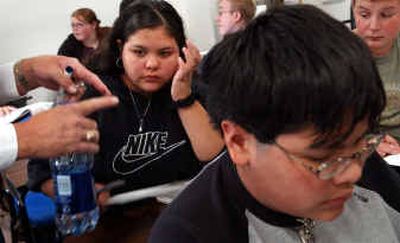Lakeside High makes U-turn

PLUMMER, Idaho – In 2002, Lakeside High had more than a thousand discipline problems during the course of a school year.
Students were dropping out of the small Plummer school almost daily.
Only 88 percent of students were in school at any given time.
“We were having second-year freshman, third-year freshman, kids who were in their third year of school here and hadn’t received one credit,” teacher Paola Trottier said.
In three short years, Lakeside High has made a major turnaround. Attendance has increased. More students are staying in school and making the honor roll. Discipline problems have dropped by more than half.
This summer, Lakeside High Principal Jim Phillips accepted a national award for the great strides students have made through the High Schools That Work school-improvement initiative. More than 1,000 schools in 31 states participate in the program. Only a handful received recognition.
Mike Sifford was starting his freshman year at Lakeside just as the program was implemented.
“We knew high school to be loose, kind of a breeze, easy to get through,” Sifford said. “I was kind of mad.”
Arthur Elwell said he “just kind of did the work and didn’t care much.”
The drastic changes at Lakeside forced students to care.
If students fell below a C in any class, they had to attend a mandatory study hall before school, during lunch or after school. Paola Trottier even runs a session on Wednesday evenings from 6 to 9.
Even with the Study Table, as it’s called, students were failing, Superintendent Wayne Trottier said.
He remembers a teacher coming to him and saying, “We’ve got problems. Our kids are drowning in failure.”
There was talk of opening an alternative school, Trottier said, but he wanted to first see what could be accomplished at the high school.
They developed “an alternative to an alternative,” Trottier said, called SWIMS. It stands for “Students With Individualized Mentoring Structures.” Because of the program’s success, Trottier has been asked to do presentations in Portland, Boise, Nashville and in Montana.
Students who didn’t do well in regular classes were withdrawn and placed into smaller SWIMS classes. Those provided more one-on-one sessions with teachers and fewer chances to fall between the cracks.
Counselor Lori Woodward said SWIMS helped students who struggled with more than academics.
“Even kids who have social and emotional problems,” she said. “They can succeed better in a smaller environment. Their grades just go up.”
Students who were getting Cs and Ds in regular classes were earning As and Bs in SWIMS.
The SWIMS teachers went through special training and became mentors to their students. They talk about what’s going on at home, with friends, grades and attendance.
“It’s not just all their academic needs,” Woodward said. “It’s all their other needs, too.”
A certain number of students are assigned to teachers for mentoring. Teachers follow those students throughout their high school career, checking in often with their teachers and meeting with the students.
Because students have the same teacher mentor for four years, Woodward said they are able to develop a bond and trust.
For the program to succeed, Wayne Trottier said the teachers and staff had to change their expectations – not only for students, but for themselves. And everyone from the school board to parents, administrators, teachers and students had to support the changes, he said.
Teachers were carefully selected to staff the program.
“Willingness is as important, or more important, than a person’s ability,” Wayne Trottier said. “They needed to care.”
Students say the care is there.
“The staff is pushing so hard,” Sifford said. “It’s not a bad pressure. And it’s not one or two teachers. They’re all trying to get us to come to school.”
And while some students originally opposed the new changes and the strictness, many are now grateful.
“You look back on the last couple of years and we’ve got more of an education than the seniors before us,” Sifford said.
“A lot of kids wouldn’t be here if they weren’t pushing us,” senior Elizabeth Townsend said. “We’d just give up.”
Wayne Trottier has been watching enrollment closely. About 40 freshmen enter the school each year and less than half were making it to senior year.
Those numbers are climbing, Wayne Trottier said.
Enrollment is up. Only a dozen or so students from last year are unaccounted for – and the district is trying to track them down.
More students are headed to college than in previous years. Of last year’s graduating class of 14, only two aren’t in college or at a trade school. Those 14 students had more than $60,000 in scholarships, loans and grants to help get them to college because of the hard work of high school staff.
“There’s no excuse,” Paola Trottier said. “There’s no, ‘I can’t go to college because I can’t afford it.’ “
Even though the school year is barely under way, Woodward said students have been coming to her and asking about their grade point averages and transcripts for college.
“That hasn’t been happening in the past at all,” she said. “The attitude of the whole school is changing.”